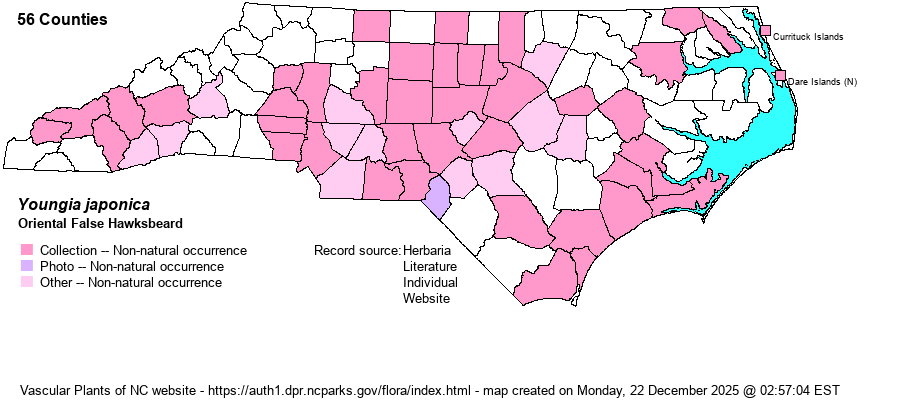| Section 6 » Order Asterales » Family Asteraceae |
Show/Hide Synonym
| taxonName | relationship | relatedTaxonName | relatedTaxonRefText | relComments |
|---|
|
| Youngia japonica | < | Youngia japonica | Gleason and Cronquist (1991) | | | Youngia japonica | < | Youngia japonica | Flora of North America (1993b, 1997, 2000, 2002a, 2002b, 2003a, 2004b, 2005, 2006a, 2006b, 2006c, 2007a, 2009, 2010) | | | Youngia japonica | < | Youngia japonica | Kartesz (1999) | | | Youngia japonica | < | Youngia japonica | Vascular Flora of the Southeastern States (Cronquist 1980, Isely 1990) | | | Youngia japonica | < | Youngia japonica | | | | Youngia japonica | < | Youngia japonica | Flora of Virginia | | | Youngia japonica | < | Youngia japonica | Wunderlin & Hansen Flora of Florida (3) | | | Youngia japonica | < | Crepis japonica | Fernald (1950) | | | Youngia japonica | < | Crepis japonica | Gleason (1952) | | | Youngia japonica | < | Crepis japonica | Radford, Ahles, and Bell (1968) | | | Youngia japonica | < | Crepis japonica | Small (1933, 1938) | | | Youngia japonica | = | Youngia japonica ssp. japonica | | | | Source: Weakley's Flora |
|
| Author | (L.) de Candolle | |
| Distribution | Found across the state, and the map is currently far under-populated with specimens. Many collection gaps have been filled in with iNaturalist photos (by late 2020), and many more are expected in the coming years for this aggressive weed. First collected in 1958 on a roadside in Pasquotank County; next in 1974 in planter beds on the campus of UNC - Chapel Hill, Orange County. Musselman et al. (1977) reported it from the Dismal Swamp in Gates County. Few records until the late 1990s, when it began an explosive expansion. For example, SERNEC lists only a single collection for Wake County, in 1997; however, it can be found in hundreds of sites in the county now.
Native of eastern Asia; in N.A. NY to OH south to FL and TX; also CA. | |
| Abundance | As of 2022, now locally common to abundant in much of the Coastal Plain and Piedmont. Seemingly still rare to uncommon in the Mountains and northwestern Piedmont. Now undergoing a very rapid expansion. | |
| Habitat | Yard weed, garden weed, campus weed in planters, sidewalks, urban and suburban streetsides, along trails, paths, and woods roads, disturbed floodplain forests. As it does range into at least openings in floodplain forests, it is potentially a noxious weed. |
| Phenology | Flowering and fruiting March-December. | |
| Identification | Oriental False Hawksbeard is similar to members of the genus Hieracium, but the flower heads are smaller and the basal leaves are lyrate lobed (varying from almost un-lobed to deeply lobed). There are 1-3 small stem leaves. The heads are yellow flowered. When seen and learned in the field it resembles no other plant, especially with its woolly-looking flowering stem. | |
| Taxonomic Comments | The Pasquotank collection is the sole representative of Y. thunbergiana in NC, but the published differences from Y. japonica are not convincing. A synonym is Crepis japonica; when RAB (1968) was published, only a single county (Pasquotank) was listed for it!
| |
| Other Common Name(s) | Asiatic Hawksbeard, Japanese Hawkweed. Often simply called "Youngia" by botanists in the state. | |
| State Rank | SE | |
| Global Rank | GNR | |
| State Status | | |
| US Status | | |
| USACE-agcp | FACU link |
| USACE-emp | FACU link |

